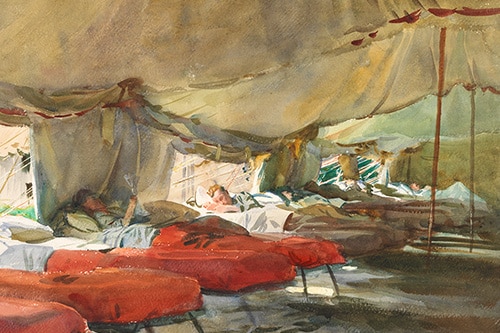Influenza: Complex Virus/Complex History
Influenza: Complex Virus/Complex History
through December 2, 2022

John Singer Sargent (1856-1925)
Interior of a Hospital Tent
Watercolor, 1918
Courtesy of Imperial War Museum, London
Organized by the David J. Sencer CDC Museum at the Centers for Disease Control and Prevention in Atlanta, Influenza: Complex Virus/Complex History traces the global impact of influenza viruses since the 1918 pandemic. Influenza viruses are biologically and historically unique. Small changes in their genes occur frequently. Abrupt major changes are less common, but can have devastating impact. In modern times, recurring influenza outbreaks have prompted virologists, medical professionals, and public health workers to search for ways to prevent influenza transmission and reduce the effects of influenza infections.
CDC, working with its worldwide partners, plays a key role in these efforts. Throughout this exhibition, the human experience with the virus is framed by the work of CDC and its partners. Influenza prevention and control capabilities have evolved along with public perceptions of influenza. Scientific advances are interwoven with recollections of influenza’s social and cultural impact to illustrate a complex global story in which each of us plays a unique, ever-changing role.
Just as influenza viruses have changed, so too has the science and the perception surrounding influenza throughout history.
While gathering materials in 1918 for Gassed, his monumental painting depicting wounded soldiers on a World War I battlefield, John Singer Sargent was suddenly stricken with influenza in Peronne, France. He was taken to a nearby hospital near Roisel, France to recover. As he spent a week lying in a hospital bed alongside wounded soldiers, Singer was inspired to paint this work.